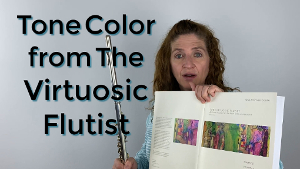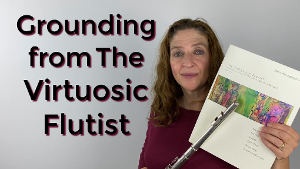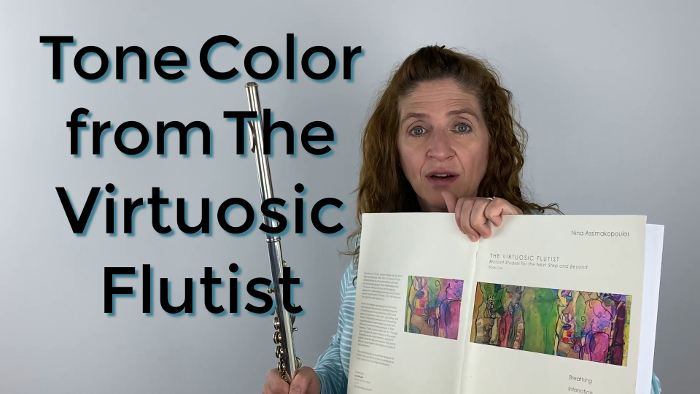What is tone color?
Tone color is one of those things that’s just a little bit ethereal. What really is tone color? And how do we do it? What does it mean when we play the flute?
I remember when I was in college, thinking, “All right, so what’s this tone color thing all about?” Up to that point I played one way, that’s it! If there were tone color changes, well, they just mysteriously happened. I didn’t really think about color, or about how I could color at will. I didn’t understand tone color, much less the fact that it is a performance tool that you can use to make your music more enjoyable to perform, and more interesting for the audience.
How Does One Change
the Color of One’s Tone?
Simply put, you can change the tone color by changing the shape of your embouchure, the tightness or looseness of your embouchure, and the angle of your airstream.
For example, If I play with my head up and embouchure long, that will give me the kind of the sound I want when I want a woody sound. That’s a tone color. If I play down, moving the angle of my air down, and widen my embouchure, it’s going to give me a completely different sound.
To talk about tone color, I’m going to use a book titled The Virtuosic Flutist which was written by a good friend of mine named Nina Assimakopoulos. You can find her on Instagram under her name and The Virtuosic Flutist. This is a great book. It’s got wonderful writing about tone color and how to achieve it. Nina also gives exercises for you to practice changing your tone color. I’ll use her exercise to explain to you how she says to start experimenting with this tone color. Then I’ll tell you how I’ll use that in a piece to vary my tone color in a performance.
Now there is a lot more that we could discuss about tone color than what I write here, but this gives you a start. It is a place to begin. This book gives you the tools to show you how to begin. When you get this book read it from beginning to end like a book. Then get your flute out and try the exercises. In the section that tone color is discussed Nina says to practice tone color by using vowels.
Think of Shaping Your Embouchure
by Saying Vowels
eee (E)
eh (A)
oh (O)
ooh (U)
Let’s talk about vowel sounds. If you make your mouth different shapes, as far as vowels go, A, E, I, O, U, they change not only your mouth shape, but also the inner cavity of your mouth. This has a direct application to your flute sound that you can apply to your playing. She uses four vowels sounds, eee(E), eh(A), oh(O), ooh(U). Say those and notice that when you say eee, you are wide, eh, a little bit wide, but longer, oh, shape is different, and ooh, those are very different shapes.
The exercise in the book uses a five-note pattern where you play these patterns with a particular vowel shape. So, an eee shape on F maybe a little bit different of a sound than an eee shape on A. Again, this is for you to experiment with, and this is just a jumping off place.
When I use the eee vowel shape, to me it’s a very present sound. I feel like it’s modern and edgy.
Then when I use the eh vowel shape, I feel that opens up the sound a little bit more. It takes some of that edge off.
Try it, I think you can clearly hear the difference between these when you change the shape of your embouchure in this manner. These differences are the nuance known as tone color.
If you watch my video, I will demonstrate how you can use these vowel shapes to change your tone color to get the effect that you want in a piece. I’ll play a passage from Bruce Stark’s American Suite, the 3rd movement called Muse. This is supposed to represent some places in Arizona and the Nevada mountains, and the ocean in California. I think specifically the ocean at night.
I’ll use these different vowel shapes and play and see what they sound like. Then I’ll decide what combinations of vowel shaped embouchure that I want to use to make the piece my own. This makes it interesting for me because I like this kind of challenge. And I like to think that it makes it more interesting for the audience.
Nuance
Noun – The subtle differences in the sounds
of the notes that you play
Verb – Using your embouchure to vary the sounds
of the notes that you play
There are four different tone colors that you now have at your disposal to use in any piece you perform. If you’ve never thought about tone colors before, or you didn’t really understand the idea, or like me, I knew I could get different colors, but didn’t know how or where do apply them. Then this gives you a great tool to use to experiment with changing the tone color.
Now is the time to start experimenting with tone color. You have a lot of different ideas presented to you in Nina’s book, After trying these exercises it’s time to try it in your solo. Take a phrase and use these vowels sounds to express this phrase differently. See what you like and then mix it by using more then one vowel sound in the phrase to change the color. There is no right or wrong. It is completely up to you. Go ahead and decide what you like.
This is where music gets to be really fun and makes practicing exciting. Music comes to life! If you’ve never practiced with tone color, get Nina’s book. Practice it, read it, do what it says. It’s going to change your playing.
Have Fun!
DoctorFlute
Watch me demonstrate this:
Tone Color from Nina Assimakopoulos book The Virtuosic Flutist FluteTips 107

Grounding from Nina Assimakopoulos book The Virtuosic Flutist FluteTips 112

